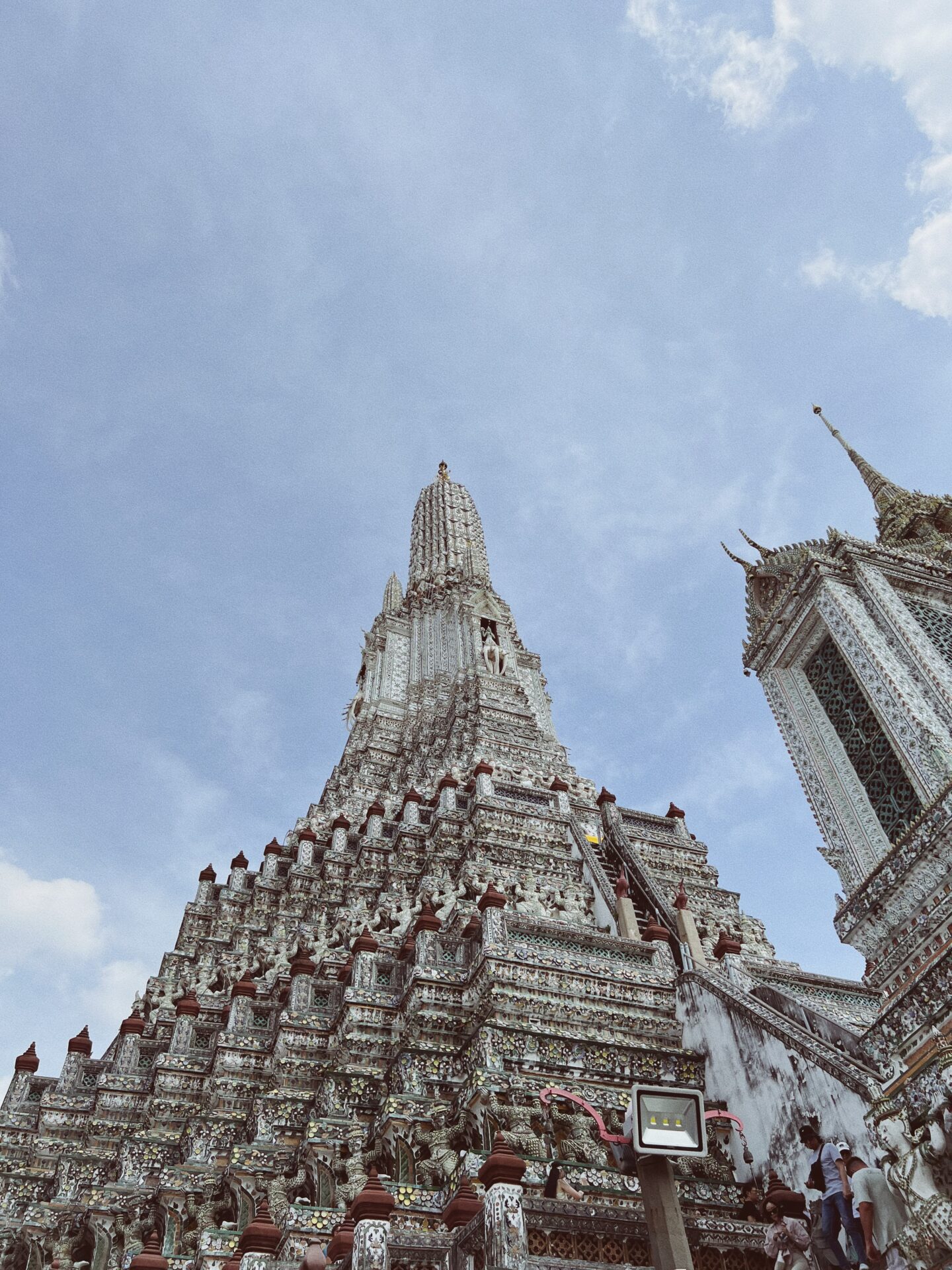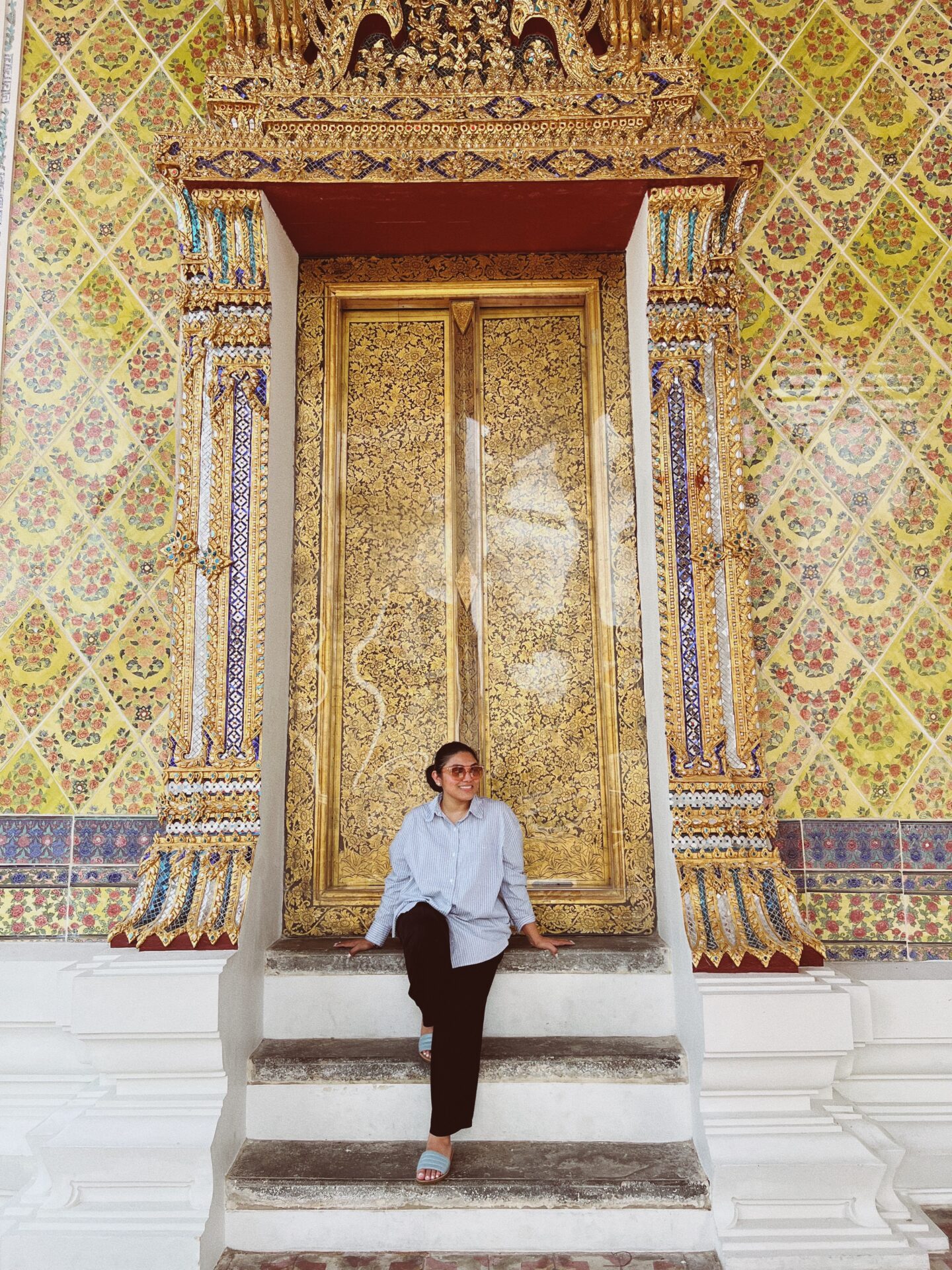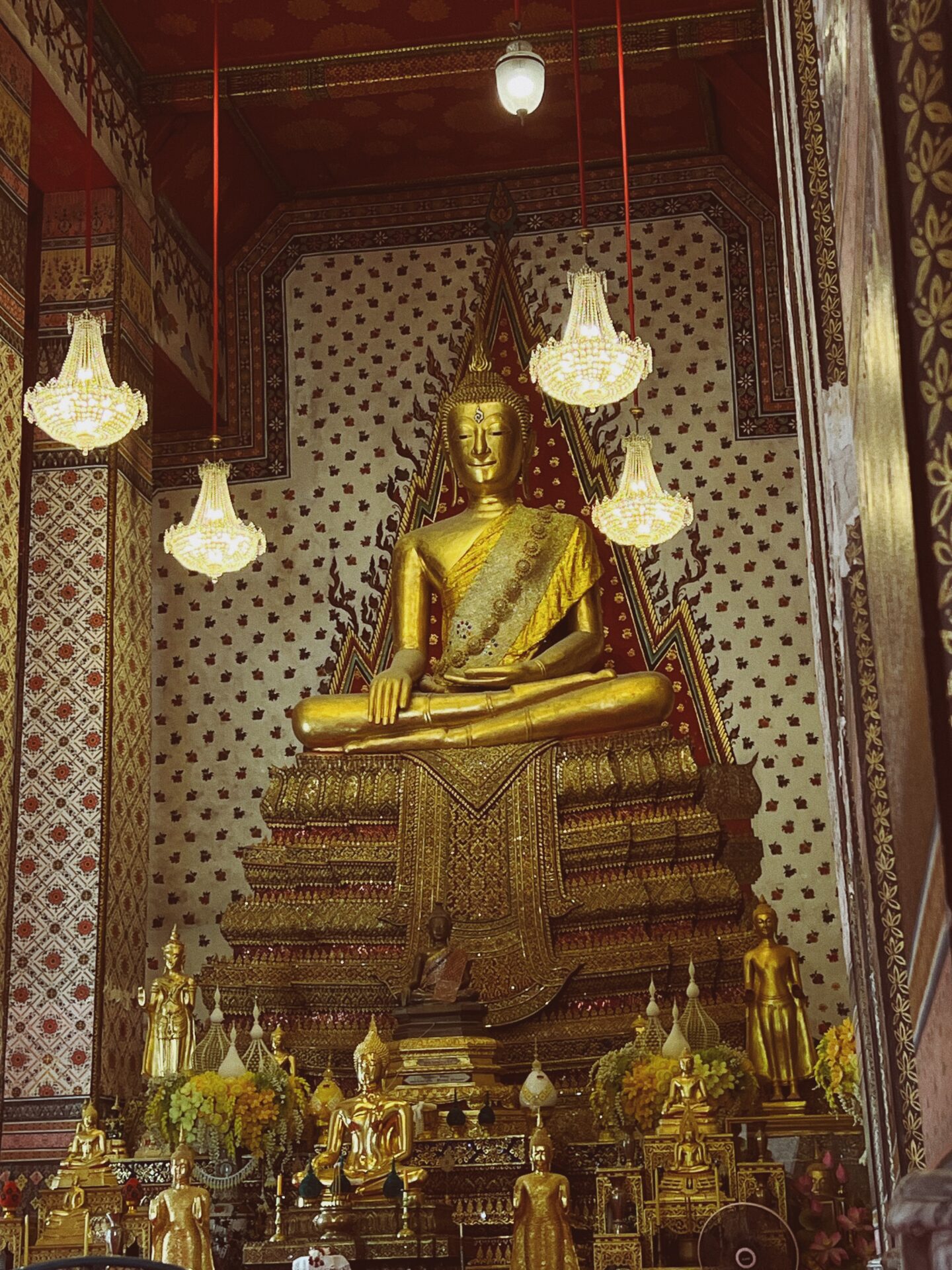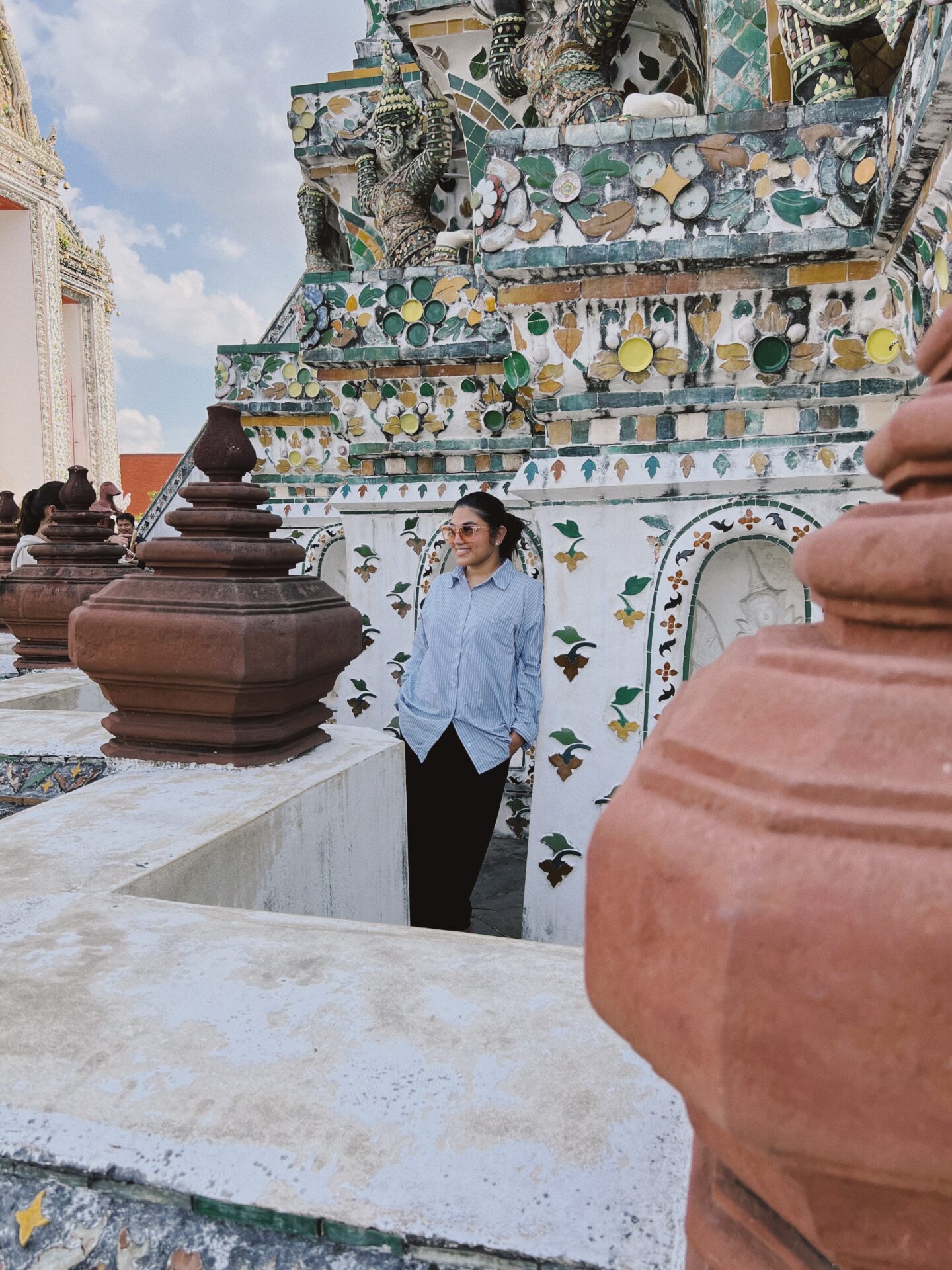The temples in Bangkok are very different from the ones I have seen in Indonesia and Vietnam. One such temple in particular has my heart and it is one of the most beautiful temples I’ve seen on my recent holiday to Bangkok.
Wat Arun, or rather, Temple of the Dawn, is magnificent and is one of Bangkok’s most iconic structures – not to mention one of the few Buddhist temples you are encouraged to climb on.
So, Bangkok connoisseurs, a visit to Wat Arun is one of the best things to do in Bangkok and should be high up on your list of must-do’s. But what are the best tips for Wat Arun in Bangkok, and what can you expect when you go there?
In this blog post, we embark on a journey to uncover this iconic temple’s origins, history, and inner sanctum, inviting you to explore the heart of Thai culture and spirituality.
#1. Origins and History


Nestled on the banks of the Chao Phraya River in Bangkok, Wat Arun, also known as the Temple of Dawn, symbolises timeless beauty and spiritual significance.
Wat Arun’s history dates back to the ancient Ayutthaya Kingdom, founded in the 17th century. Initially named Wat Makok, the temple was renamed Wat Arun after the Indian god of dawn, Aruna. Legend has it that King Taksin, after escaping the fall of Ayutthaya, arrived at the site at dawn and proclaimed it the new capital. In honour of the auspicious moment, he renovated the temple and renamed it Wat Arun.
The temple’s architecture reflects a blend of Thai and Khmer styles, with its towering prang (Khmer-style tower) adorned with intricate ceramic tiles and colourful porcelain fragments. The central prang, standing over 70 meters tall, symbolizes Mount Meru, the centre of the universe in Hindu and Buddhist cosmology. Surrounding the prang are four smaller satellite prangs, representing the four winds.
#2. Entry Fee
As of my last visit, the entry fee for Wat Arun was approximately 100 Thai Baht for foreign tourists. However, it’s essential to check for any updates on entry fees before planning your visit, as prices may vary over time.
Fees: THB 100
#3. Inside Wat Arun

Upon entering Wat Arun, visitors are greeted by a serene atmosphere infused with the scent of incense and the soft murmur of prayers. The temple complex comprises various structures, including the main prang, halls, pavilions, and smaller shrines.
One of the highlights of exploring Wat Arun is ascending the steep staircase of the central prang. As you climb higher, you’ll be rewarded with breathtaking panoramic views of the Chao Phraya River and the surrounding cityscape. The climb may be challenging, but the awe-inspiring vistas from the top make it a truly unforgettable experience.
Throughout the temple grounds, intricate carvings, statues of mythical creatures, and ornate decorations abound, offering insight into Thailand’s rich cultural heritage and religious traditions. Visitors can also participate in Buddhist rituals, such as lighting incense sticks and offering prayers at the various shrines scattered around the temple complex.
#4. The question is, how do you get there?
There are a few ways to get to Wat Arun, and here are a few possibilities:
Boat: One of the most scenic and convenient ways to reach Wat Arun is by taking a boat along the Chao Phraya River. You can hop on a river taxi or express boat from various piers along the river, such as Tha Tien Pier or Tha Chang Pier. From there, you can either take a cross-river ferry directly to Wat Arun or enjoy a stroll along the riverbank to reach the temple.
Tuk-Tuk: Tuk-tuks are a popular mode of transportation in Bangkok and offer a fun and adventurous way to get around the city. You can easily hail a tuk-tuk from most areas in Bangkok and negotiate a fare to take you to Wat Arun. Just make sure to agree on the price beforehand to avoid any misunderstandings.

Taxi or Grab: Taxis are readily available throughout Bangkok, and you can easily hail one to take you to Wat Arun. Alternatively, you can use the Grab app, which is similar to Uber, to book a ride directly to the temple.
Tip: Be sure to check traffic conditions beforehand, especially during peak hours, to avoid delays.
Guided Tour: Joining a guided tour is another hassle-free way to visit Wat Arun, especially if you prefer to have transportation and a knowledgeable guide arranged for you. Many tour companies in Bangkok offer half-day or full-day tours that include visits to major attractions like Wat Arun, providing you with valuable insights into the history and significance of the temple.
Whichever option you choose, visiting Wat Arun is a must-do experience in Bangkok, offering stunning architecture, breathtaking views, and a glimpse into Thailand’s rich cultural heritage.
Dress code
As Wat Arun is a Buddhist temple, visitors must wear culturally appropriate clothing to visit. This means trousers or long skirts and tops that cover your shoulders. It also means nothing see-through.

If you are showing too much skin, you’ll have to rent a sarong from the shop at the entrance for 20B (and a 100B refundable deposit). Shoes will also need to be removed before entering some parts of the temple.
Sunset at Wat Arun
Don’t miss the sunsets at Wat Arun! It’s hard to find a more magical experience than witnessing the beauty of this temple at dusk. Across the river, you’ll discover several rooftop bars offering the finest views of Wat Arun. For the ultimate sunset view of Wat Arun, head to the rooftop terrace of Eagle Nest at the Hotel Sala Arun, known as one of Bangkok’s top rooftop bars. From there, you can capture stunning photos of Wat Arun and savour the sunset starting at 6:00 pm. Wat Arun is especially captivating at night when it’s illuminated, offering a truly unforgettable sight.
Tip: Even if you’re not staying at the Hotel Sala Arun, you can still visit its Eagle Nest bar. However, please note that there is a minimum spending requirement to secure a seat or a view at the bar. It’s not a complimentary entrance, and the amount you’ll need to spend is higher than what you’d typically spend on a coffee latte for the view.


In short, Wat Arun stands as a testament to Thailand’s rich history, architectural prowess, and spiritual devotion. Exploring its inner sanctum is a journey of discovery, offering a glimpse into the country’s cultural tapestry and the enduring legacy of its ancient civilizations. Whether you’re a history enthusiast, a spiritual seeker, or simply a lover of beauty, a visit to Wat Arun promises to be an enriching and unforgettable experience.